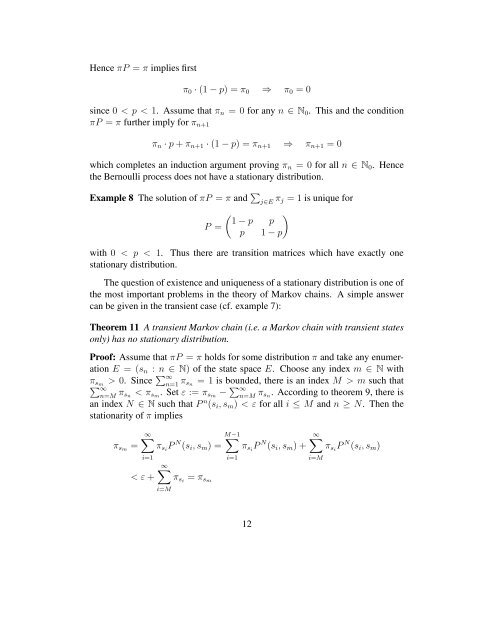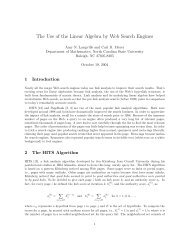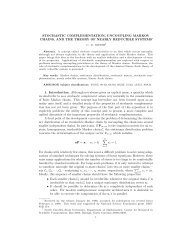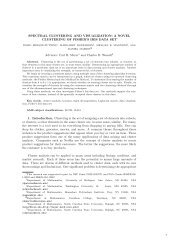Hui's reference material on Markov chains (pdf)
Hui's reference material on Markov chains (pdf)
Hui's reference material on Markov chains (pdf)
You also want an ePaper? Increase the reach of your titles
YUMPU automatically turns print PDFs into web optimized ePapers that Google loves.
Hence πP = π implies first<br />
π 0 · (1 − p) = π 0 ⇒ π 0 = 0<br />
since 0 < p < 1. Assume that π n = 0 for any n ∈ N 0 . This and the c<strong>on</strong>diti<strong>on</strong><br />
πP = π further imply for π n+1<br />
π n · p + π n+1 · (1 − p) = π n+1 ⇒ π n+1 = 0<br />
which completes an inducti<strong>on</strong> argument proving π n = 0 for all n ∈ N 0 . Hence<br />
the Bernoulli process does not have a stati<strong>on</strong>ary distributi<strong>on</strong>.<br />
Example 8 The soluti<strong>on</strong> of πP = π and ∑ j∈E π j = 1 is unique for<br />
( )<br />
1 − p p<br />
P =<br />
p 1 − p<br />
with 0 < p < 1. Thus there are transiti<strong>on</strong> matrices which have exactly <strong>on</strong>e<br />
stati<strong>on</strong>ary distributi<strong>on</strong>.<br />
The questi<strong>on</strong> of existence and uniqueness of a stati<strong>on</strong>ary distributi<strong>on</strong> is <strong>on</strong>e of<br />
the most important problems in the theory of <strong>Markov</strong> <strong>chains</strong>. A simple answer<br />
can be given in the transient case (cf. example 7):<br />
Theorem 11 A transient <strong>Markov</strong> chain (i.e. a <strong>Markov</strong> chain with transient states<br />
<strong>on</strong>ly) has no stati<strong>on</strong>ary distributi<strong>on</strong>.<br />
Proof: Assume that πP = π holds for some distributi<strong>on</strong> π and take any enumerati<strong>on</strong><br />
E = (s n : n ∈ N) of the state space E. Choose any index m ∈ N with<br />
π sm > 0. Since ∑ ∞<br />
∑ n=1 π s n<br />
= 1 is bounded, there is an index M > m such that<br />
∞<br />
n=M π s n<br />
< π sm . Set ε := π sm − ∑ ∞<br />
n=M π s n<br />
. According to theorem 9, there is<br />
an index N ∈ N such that P n (s i , s m ) < ε for all i ≤ M and n ≥ N. Then the<br />
stati<strong>on</strong>arity of π implies<br />
π sm =<br />
∞∑<br />
π si P N (s i , s m ) =<br />
i=1<br />
< ε +<br />
∞∑<br />
i=M<br />
M−1<br />
∑<br />
i=1<br />
π si P N (s i , s m ) +<br />
∞∑<br />
π si P N (s i , s m )<br />
i=M<br />
π si = π sm<br />
12











